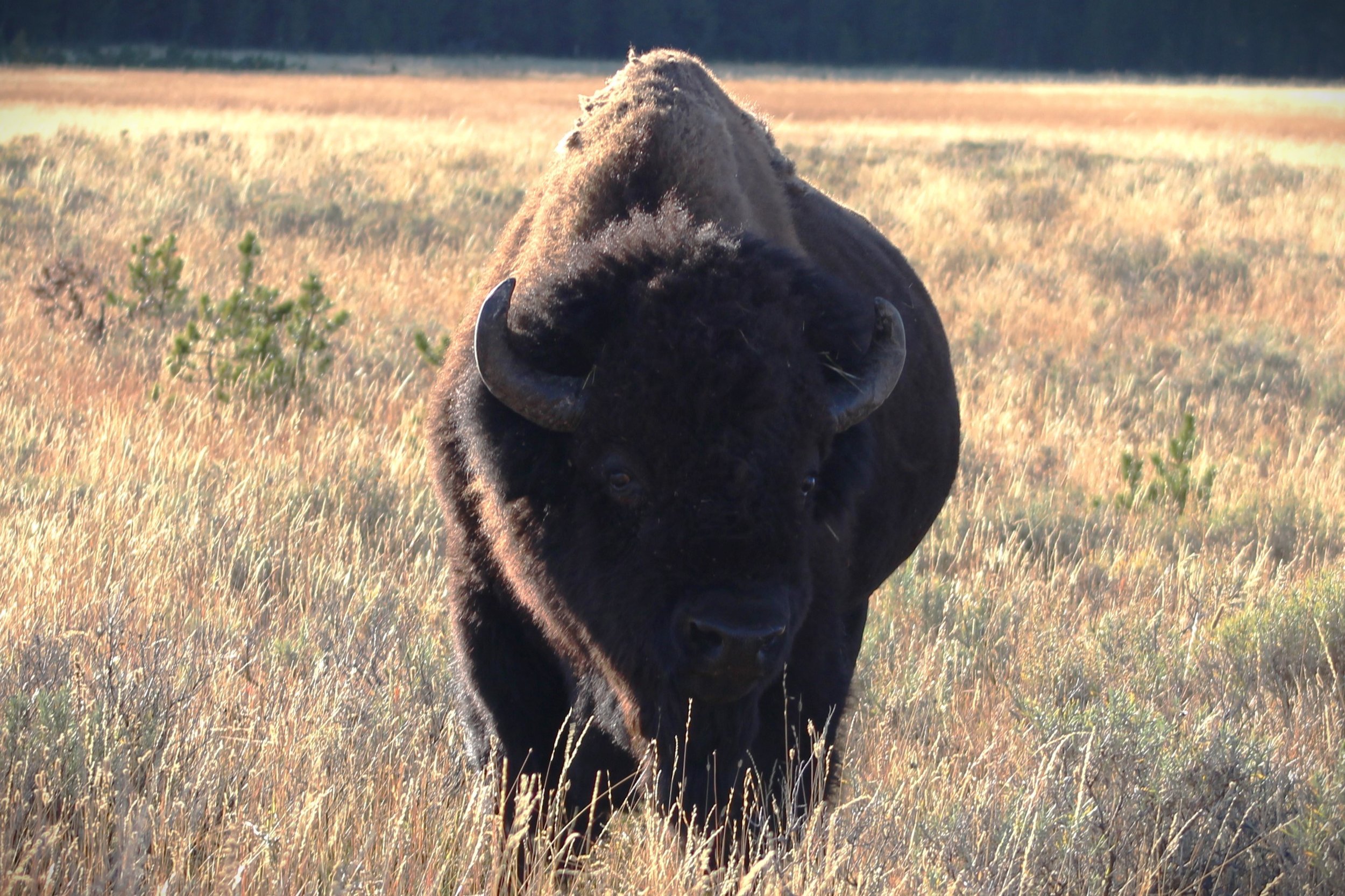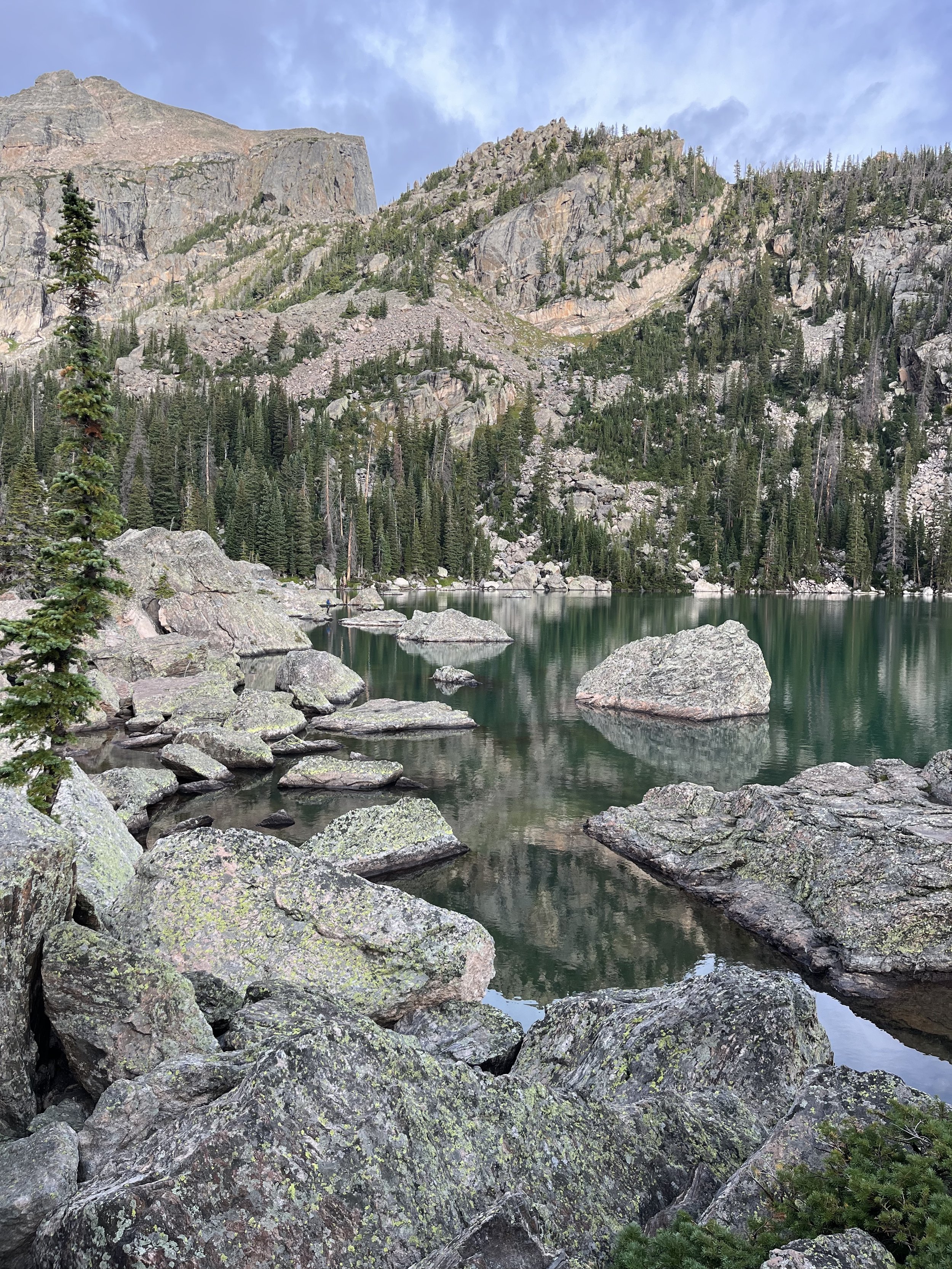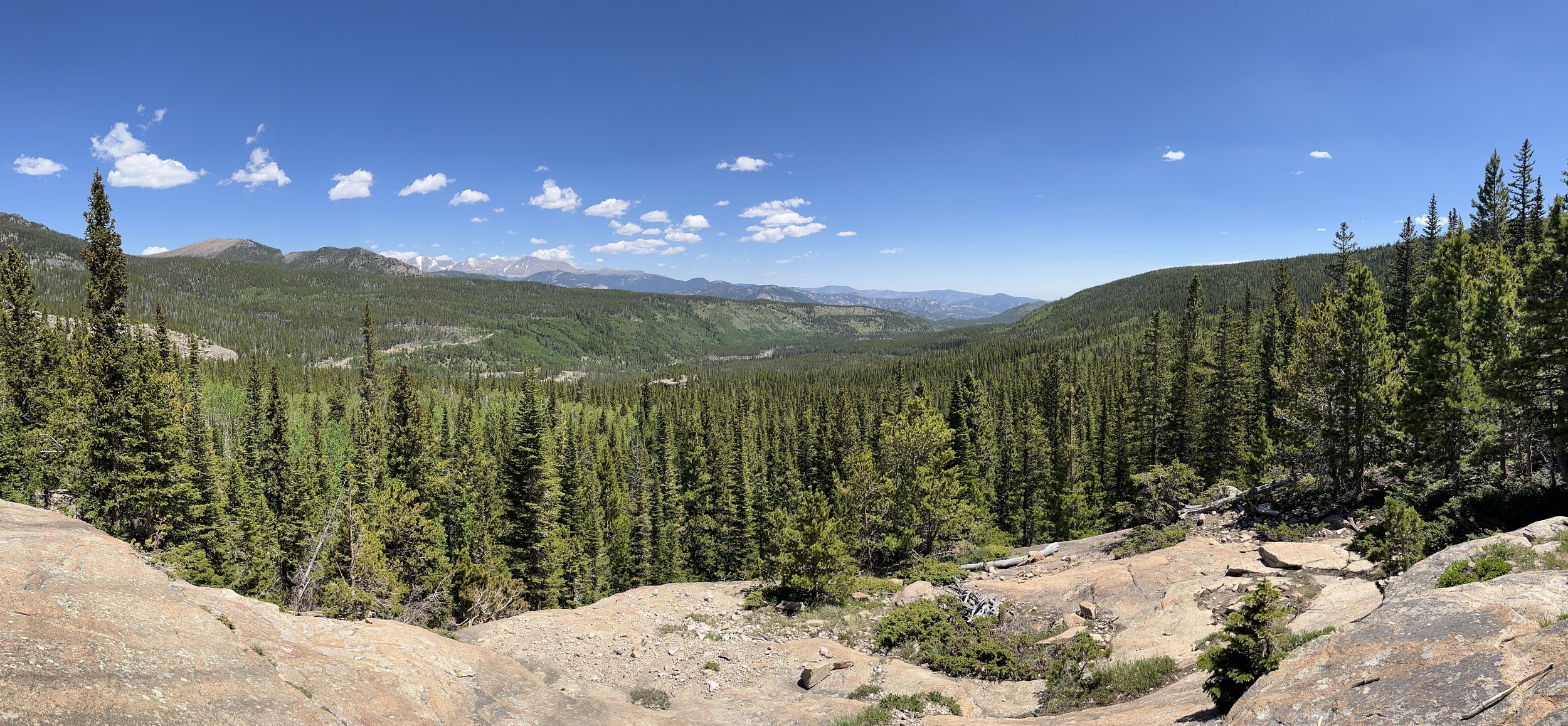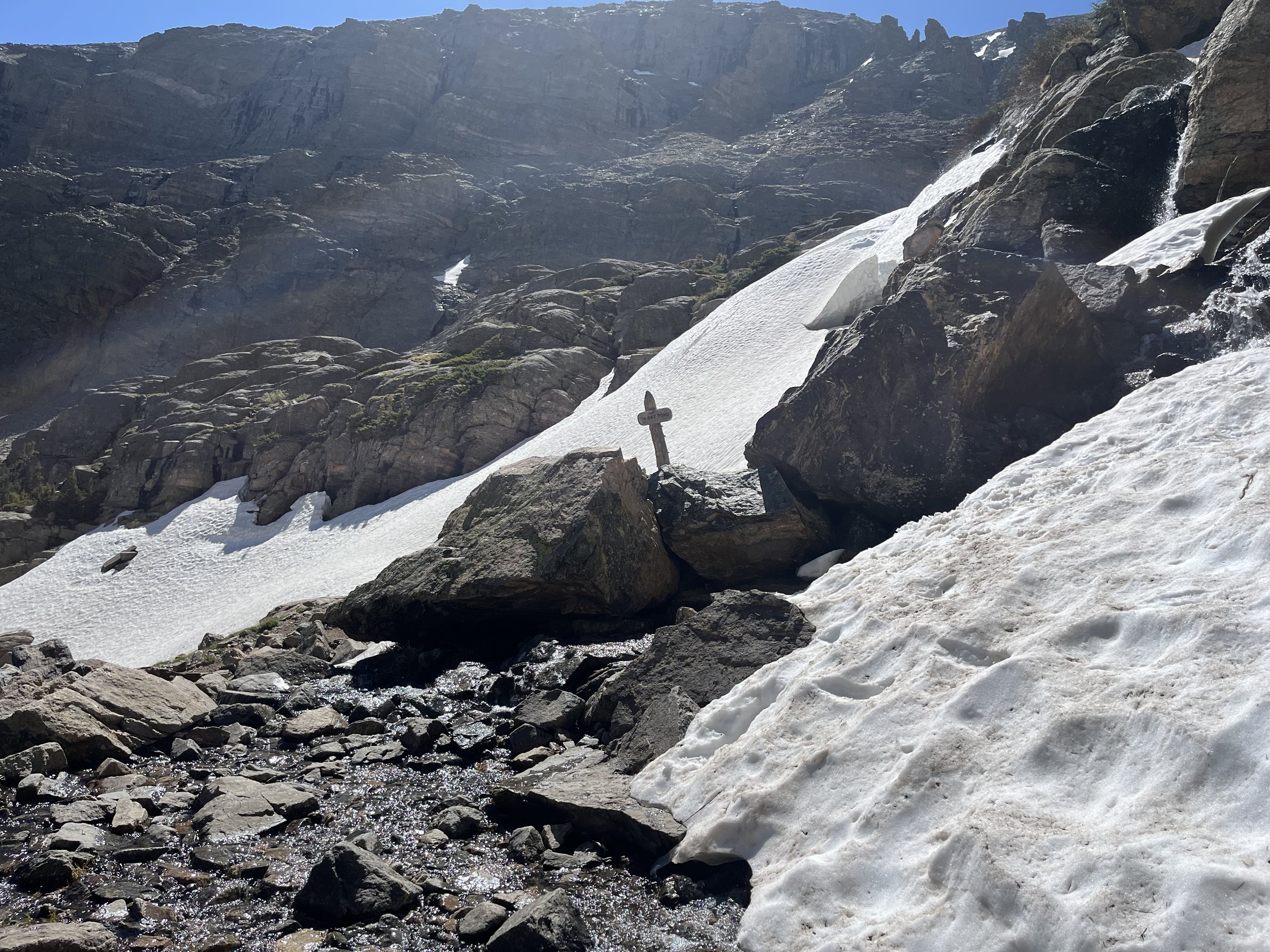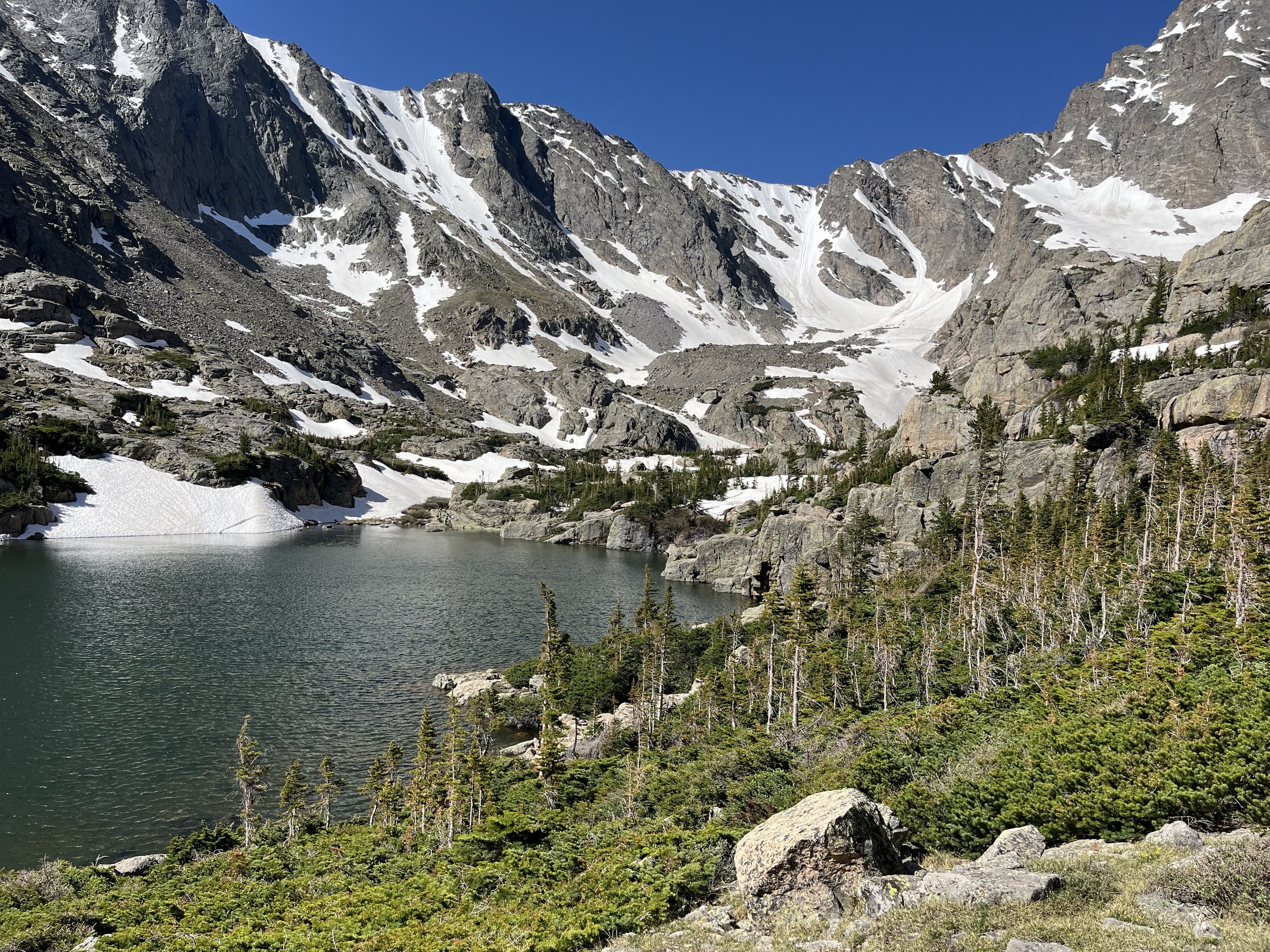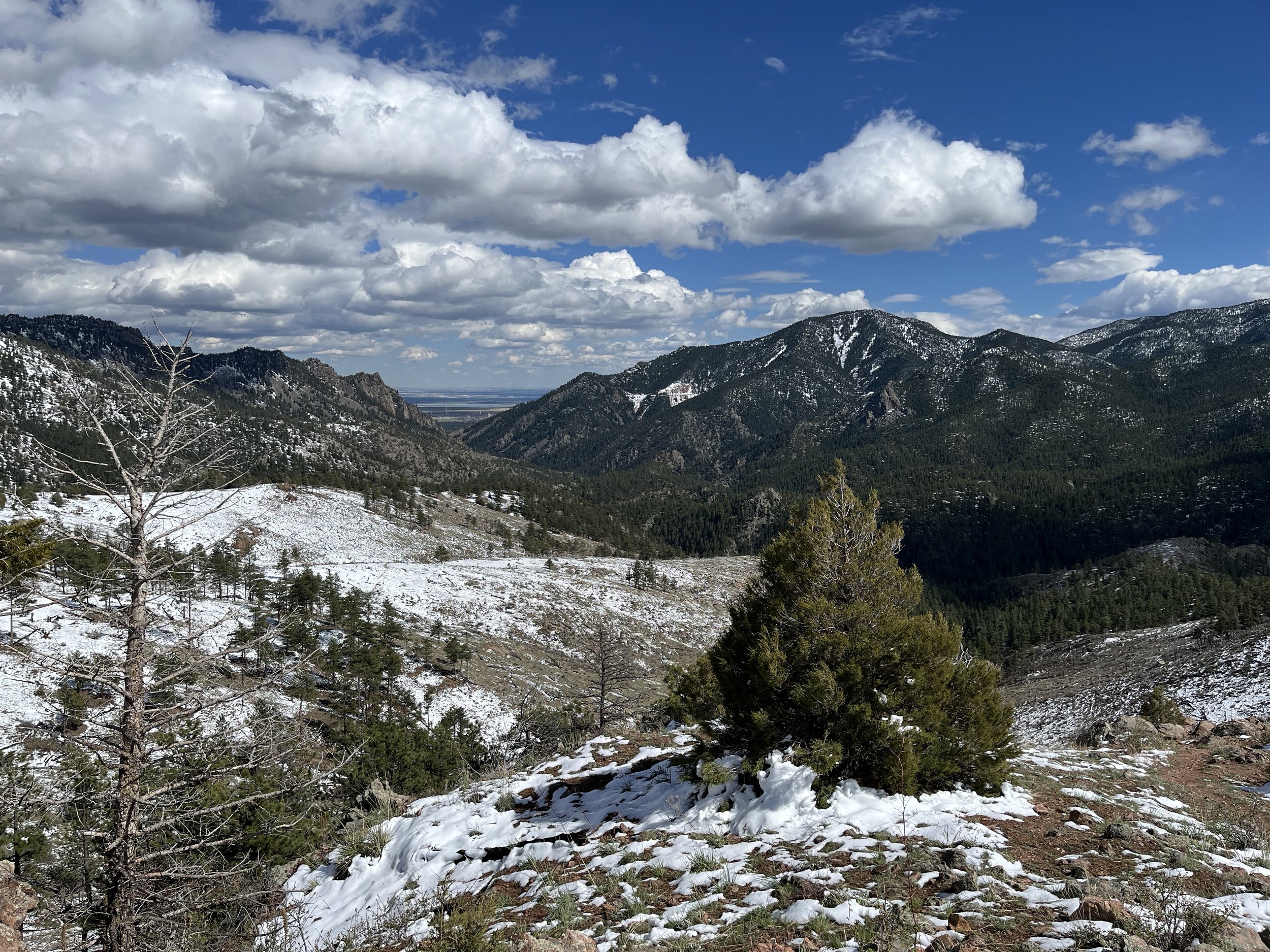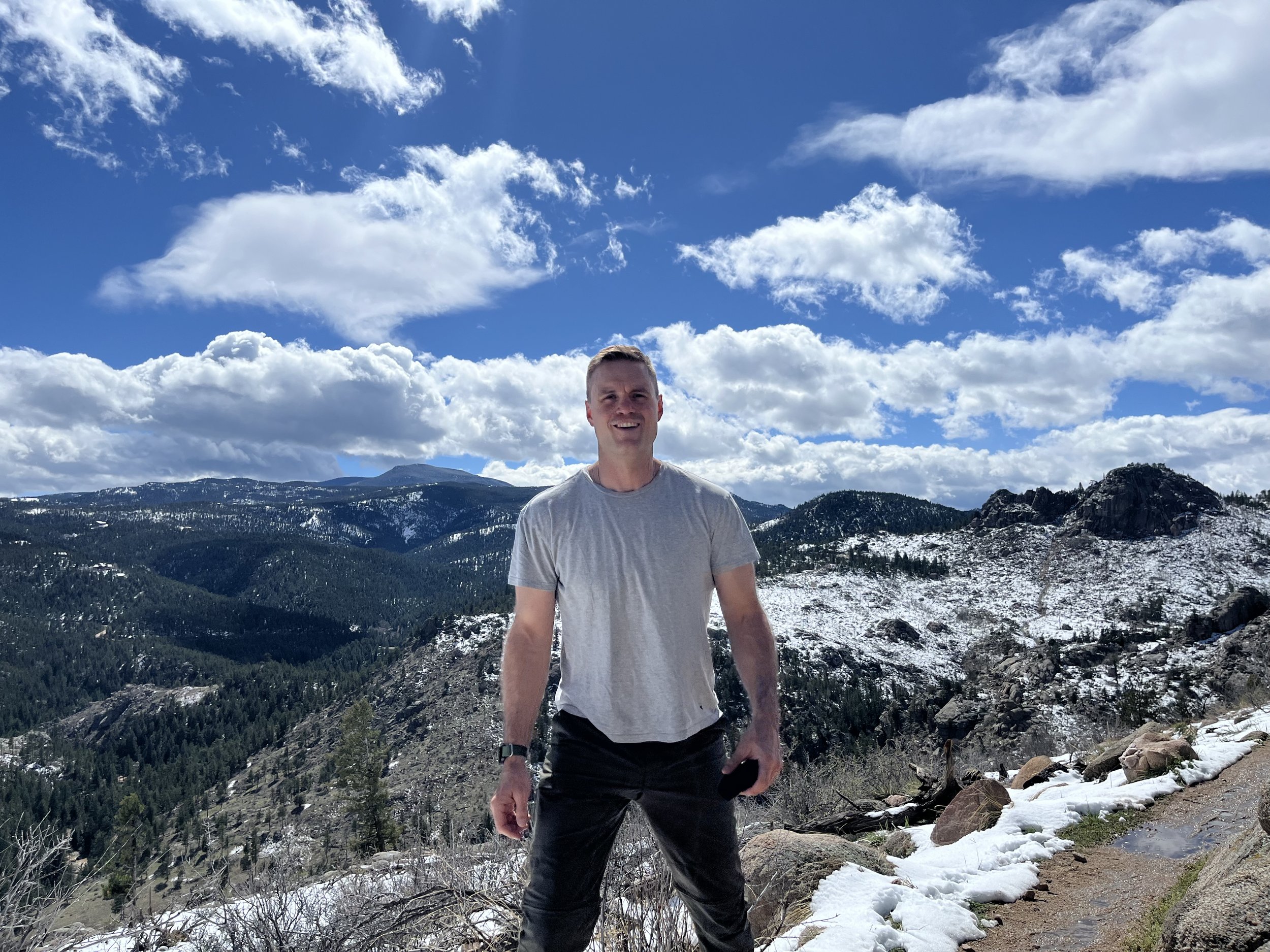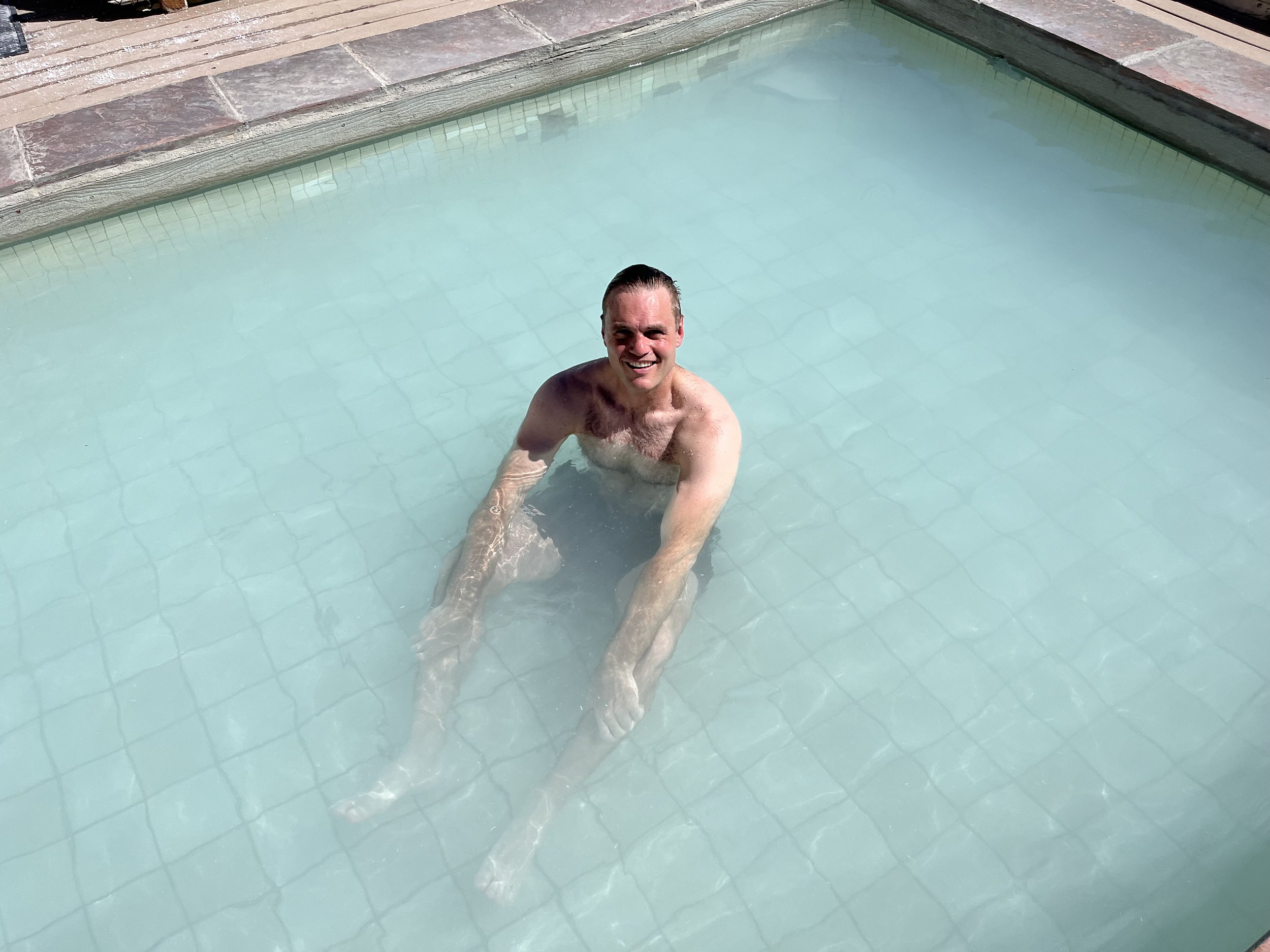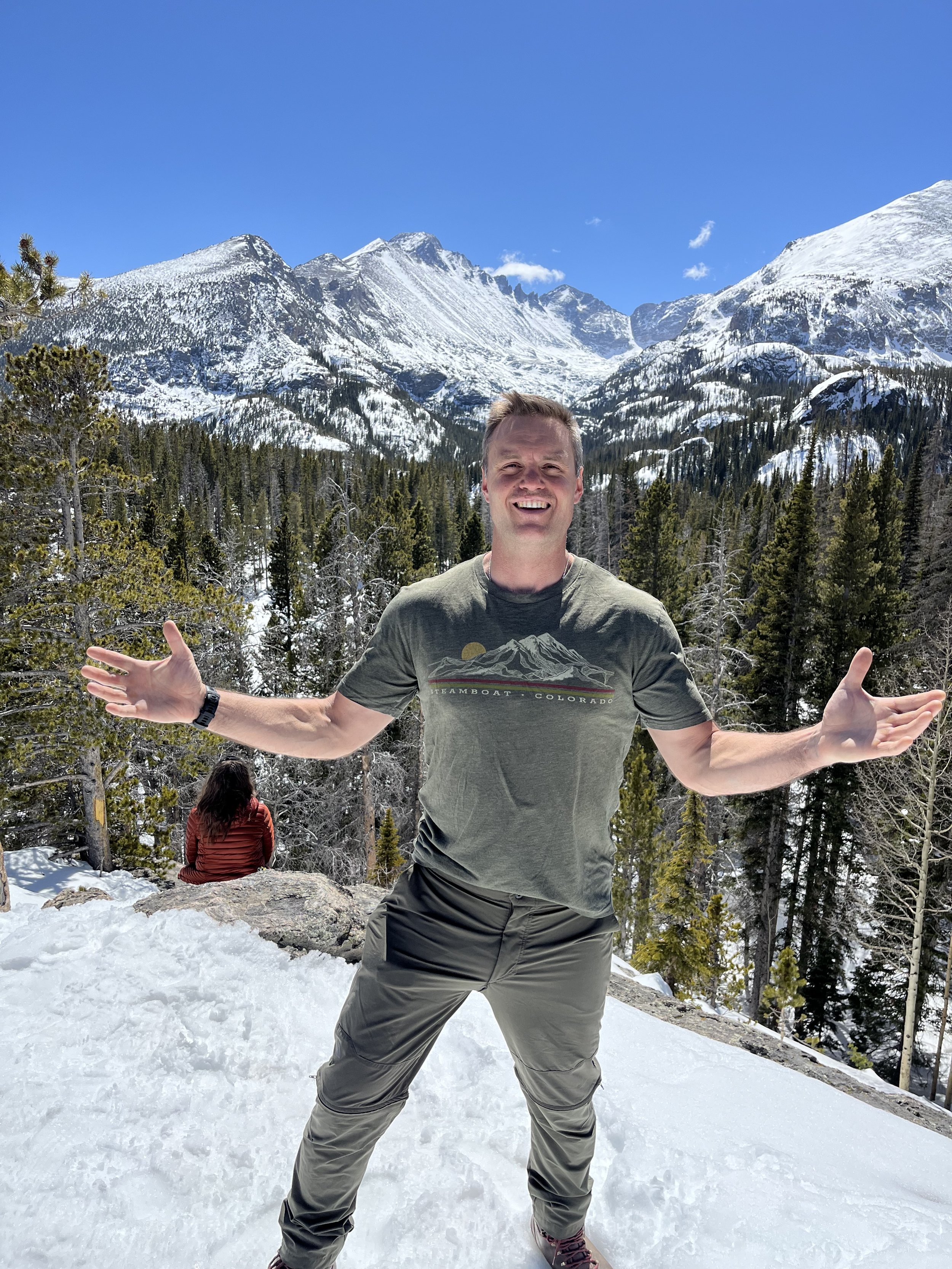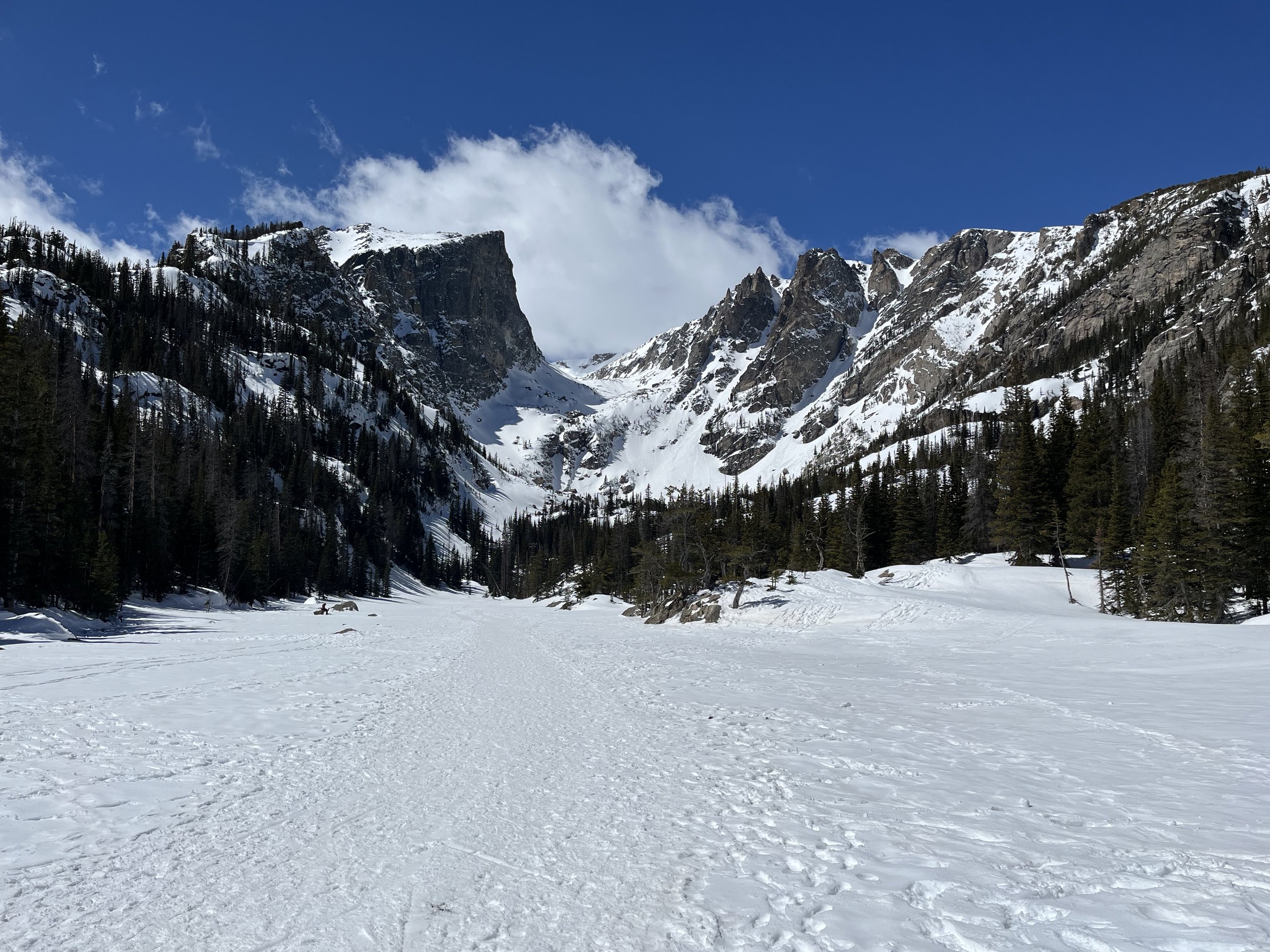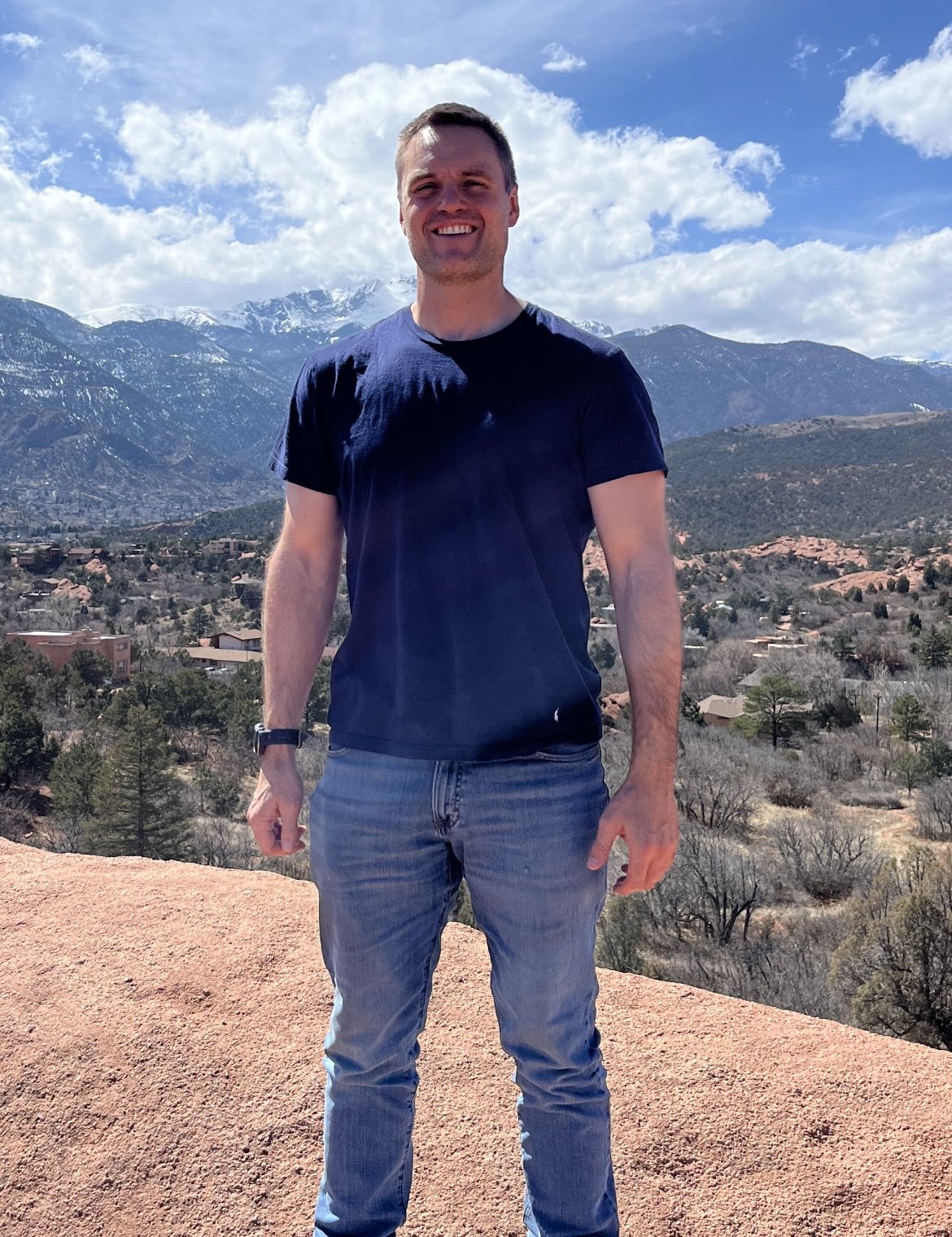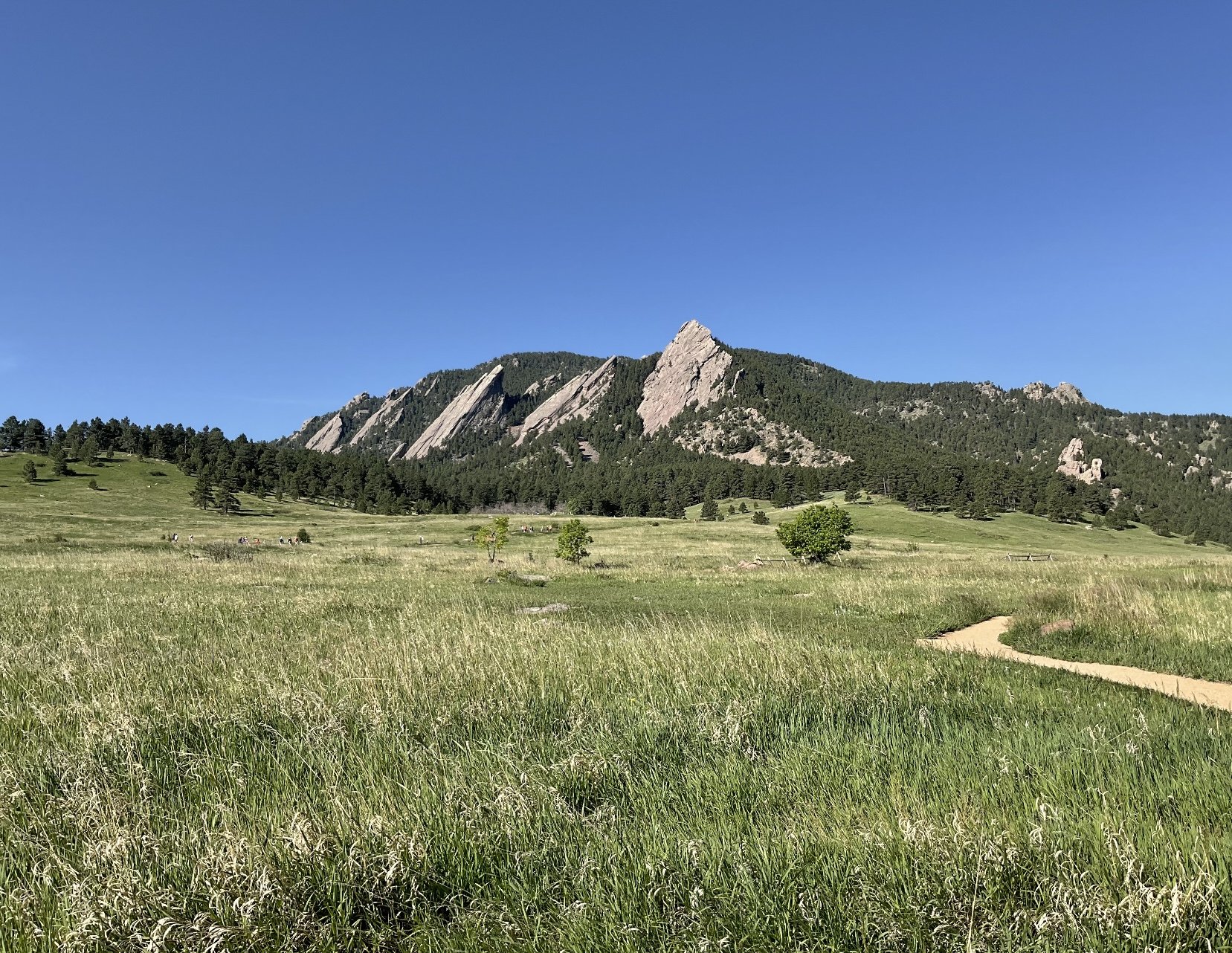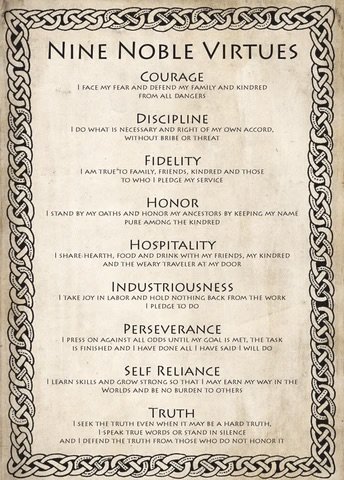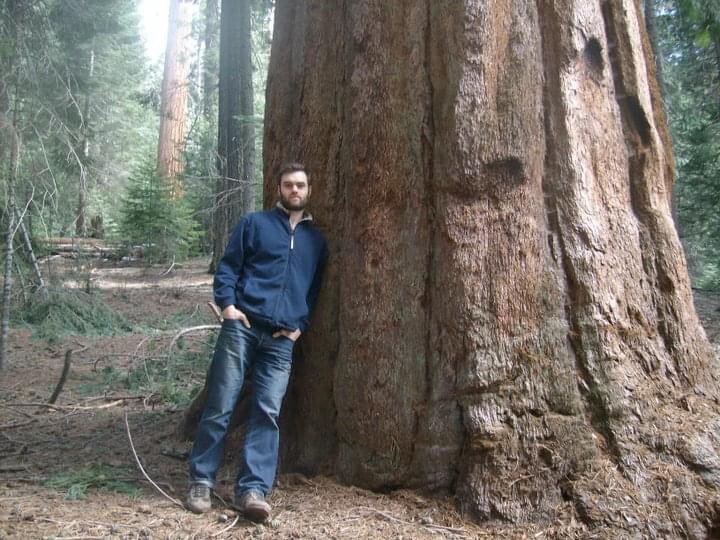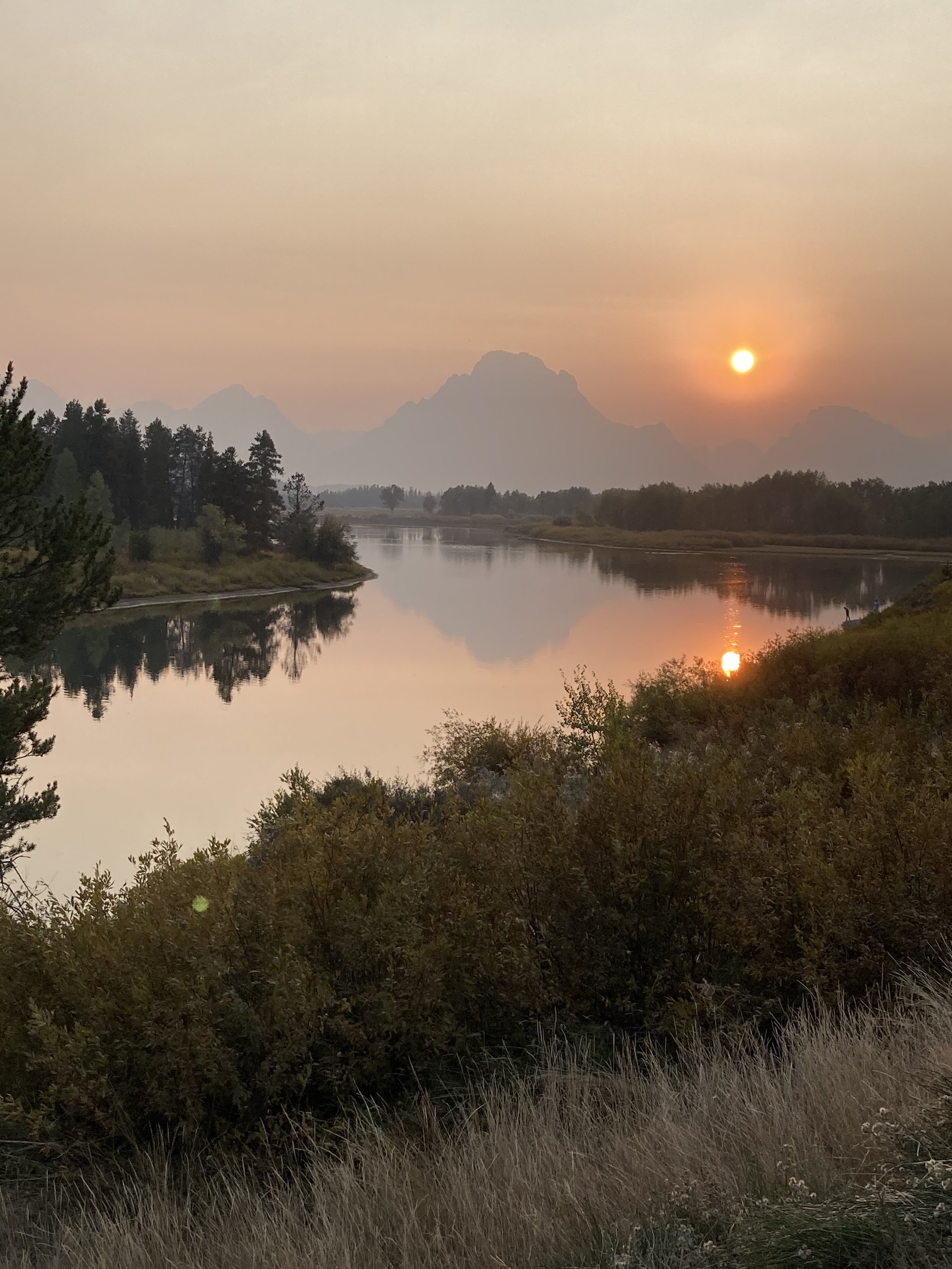Conquering Yellowstone and Teton in 3 days
Can it be done? It can, I tell you, and we did it! This was my 3rd or 4th trip to Teton and Yellowstone and a pretty darn good one at that. We saw bears, moose, elk, bison, and a wolf or a coyote (too far away to tell). In addition to that, we saw the sites! And what sites there were to be seen! Teton brings the views in ways that Colorado cannot match. They’re more jaw dropping. Colorado is a beautiful place to live and have as a base, but when you see the Tetons, you have to take a step back. You don’t necessarily have to do that in Colorado.
A while back, I came upon a new idea for the national parks: to primarily skim the parks in addition to doing a 1 or 2 deeper dives, in the form of long hikes, to get a better view. This trip, we ended up doing three hikes. A lot of people, and especially those visiting Yellowstone, sit and wait at specific locations for wildlife to emerge from the woods, or they think they are going to spend hours at each site (like Old Faithful) and end up wasting a lot of time just soaking in one or two locations. Many of the sites in Yellowstone and Teton are single hour sites. Watch Old Faithful erupt, walk around and see the other geysers and keep moving. You don’t have to watch it erupt several times and you can only see a certain number of geysers before it starts to get old. In addition, wildlife prefer to be out and about at certain times of the day and if you can learn when and where, you can just go to those places and not waste your whole day waiting on an event that may or may not happen. You’re likely going to see wildlife anyway (Yellowstone is an outdoor zoo) and, plus, there are tons of other things to see that are also good. You could potentially ruin a whole trip if you just sit in one spot.
I call this the “spider method.” You spread out like a web, but you have certain areas in which you stop and hang out for longer periods of time.
In three days time, we:
Saw Jenny Lake at night
Caught sunrise at Schwabacher’s Landing and Jenny Lake and saw two moose on the way
Saw Old Faithful erupt and took pictures of the other geysers
Went to Fairy Falls and captured Grand Prismatic Spring from above
Went to Norris Geyser Basin
Hiked Storm Point Trail
Saw a grizzly eating a bison as well as a wolf/coyote in Hayden Valley, plus boatloads of (live) roaming bison
Captured the (smokey) sunrise at Mormon Row
Saw the Grand Canyon of the Yellowstone
Hiked the Sublime Point trail at the GCY
Saw Tower Falls
Saw a blackbear resting peacefully on a tree at Roosevelt
Saw Yellowstone’s petrified tree
Spent an evening in Lamar Valley and didn’t see a darn thing except for more buffalo
Hiked the Death Valley trail down to Phelp’s Lake
Jumped off of jumping rock and had a picnic afterwards
Ate lunch and captured some awesome images at Dornan’s
Black Bear
Another thing I want to bring up is the cost effectiveness of an adventure like this. Driving all the way there from Boulder, Co and paying for 3 nights of camping, the total cost of the trip was around $400 for me. 8 hours of driving each way. A certain someone spent more money on food and accessories than was necessary if you just want to have a nice time. I’m not including that stuff because you are going to eat food regardless of whether or not you go to Yellowstone. If you want to go to Yellowstone and Teton on the cheap, in comparison to an exotic vacation elsewhere, you can! I made a vlog about our 3 day packed Yellowstone and Teton trip below:
Pikes Peak
I got an unusual tour request the other day: to take 36 people (my understanding was that they were internationals) on a bus up to Pikes Peak. One of the most common issues with guiding people is that you often get requests that just don’t work or they threaten the integrity of your business’ reputation in some way.
Pikes Peak is a 14er. It’s one of just two in Colorado (the other is Mt. Evans) that you can drive all the way to the top of. It’s a 19 mile road with switchbacks that takes you about 40 minutes to wind up and up and up if you don’t make any stops. Car sickness is an issue even in a regular car if you are prone to it. For those of you that have never been at 14,000ft, you might feel it in your head. I’m good at the 12,000ft mark, but anything above that and I am feeling woozy. It you are stuffy, then you are going to feel it.
Strangely, Pikes Peak is home to a famous car race called the Pikes Peak International Hill Climb. Nowadays, the winner’s of the race are making it in under 9 minutes!
The mountain is one of the obvious things to do in Colorado Springs along with Garden of the Gods and eat a burger at The Skirted Heifer with their cheese skirts and focaccia buns.
Pikes Peak offers good views from the road as well as trails, picnic areas, and spots slightly offset from the road to take pictures. It costs $15 for adults and $5 for kids (and, of course, they offer a military discount). There are a couple of souvenir shops and all the regular things. It’s open year around, but keep in mind that the road starts to close at high altitude when the weather becomes too inclement (the weather up there).
Since I am a Boulder tour guide, I am not there too often. A one and done, drive up, drive down, take pictures along the way is something like a 7/10 experience.
RMNP’s No Longer Best Kept Secret
Lake Haiyaha has sometimes been referred to as Rocky Mountain National Park’s best kept secret. You walk up the slope to the left of Dream Lake, follow it around the mountain and you’ll get to an alpine lake as green as jade and surrounded by big boulders that you skip from one to the next to get around. I think it is the prettiest lake in RMNP. It’s relatively easy to get to in comparison to Sky Pond and the unpronounceable name has likely made it less popular amongst tourists, historically speaking. So many people have written about it now though, and made videos, that word is pretty thoroughly out. I got there by 8am this morning and there were two people already there floating on a dinghy, a drone flying overhead, and lots of people picnicking and taking pictures on the boulders surrounding the lake. Nonetheless, it is still a very peaceful lake and good spot to hang out for a morning (or an afternoon), especially if you can make your way to the other side where there will be no people at all basically.
Serenity Lake
It’s actually called Timber Lake in Rocky Mountain National Park but it’s just so peaceful. The whole trail is. It feels like walking through the Swedish woods, then being transported to a meadow in the Austrian Alps in the Sound of Music and then ending up back in Colorado at a very nice, serene, alpine lake.
I might include this trail on future hikes with clients. The Colorado river, across the street from the parking lot, offers a nice little place to have a snack. In addition to that, the Timber Lake trail itself, despite being long, is slightly easier and prettier than Sky Pond.
There are a number of streams, lots of babbling brooks and small “waterfalls,” in addition to good wildlife viewing areas.
The trail is about 10 miles long, has an elevation gain of 2,365ft, and took me about 3 hours up and down (I ran some of it)-plus 1 hour to just hang out at the lake. There is a section that has been damaged by a landslide, but with some careful steps and a little crouching, you can get through it: it’s only about a 10ft section. I probably saw 8-10 people the whole time I was there, which is also a perk.
RMNP’s Gamer Hike: Sky Pond
I hiked Sky Pond the other day, one of Rocky Mountain National Park’s best hikes. It’s set up like a video game. It’s long, there are beautiful check points in the form of lakes along the way that give you a little kick, and then there is a boss at the end that will kick your butt.
The hike is 9 miles long. There and back takes me about 5hrs, stops for picture and video taking included. It’s straight uphill for a total of 1,780 feet (543m) of elevation gain and ends at about 9,200ft (2804m). It’s yet another hike where you have to be in shape. I know there are a few people on social media saying you don’t have to be, but they are turning 5 hour hikes into 10 hour hikes and that’s just not fun-for me, at least. There’s a certain amount of “go,” and “let’s get this done,” that is a part of the fun, if you know what I mean.
Besides the elevation gain, the kicker here is that boss at the end. For an American trail, it’s really on the dangerous side. If you go the normal way, you have to traverse a steep snowy cliff (even in June) sideways for about 300ft and then climb up a small waterfall through the actual water on wet rocks. It sounds cooler than it is. It’s actually kind of sketchy. The prize at the end though is worth it. You’ll have to do the hike to see it.
Glass Lake, 200 ft from Sky Pond.
American Keystone
The North American Bison has caught my attention. In fact, it’s got its hooks in me. Did you know that, historically, bison were North America’s most prominent native herbivore and that they are our largest land mammal? Did you know that cattle are not native to the US and Canada?
Bison were nearly eradicated from North America due to over hunting and an attempt made by the US government to make life difficult for the Native American by killing them all. At one point, they were being shot from trains simply left to rot without even the hides being used!
In regards to their place of origin, animals are categorized as native, non-native, and invasive. Bison are native to North America. There are two species here: plains and wood bison. Cattle are non-native, meaning they were imported from elsewhere (Europe). Interestingly, people increasingly refer to cattle as invasive, rather than just non-native. Google it. The distinction is made when a species is deemed harmful to its environment and the plant and animal life around it.
Cattle are as domestic and docile as they come and they also produce a lot of food for people. What’s the deal?
Cattle don’t seem to know the environment like bison do. They didn’t grow up here. Despite their docile nature, cattle are running around, metaphorically speaking, kind of like a bull in a China shop. They are just doing whatever, while bison are more specialized for their environment.
Bison trend towards being more sustainable for the US.
They seem to be more selective eaters. They like native prairie grasses and they tend to not prefer broad leafed plants and flowers. That’s good for American prairies, which are threatened. They eat the grasses which then creates more room, nutrients, and water for prairie flowers to grow and lets bees and birds do their thing to pollinate them (and grow in number). Cattle seem to trend towards forbs (broad leafed plants) over grasses.
Bison wallow as well; meaning they lay down and roll around in the same spots over and over again. This creates depressions in the ground where water collects and can turn dry fields into wetlands (this is why beavers are important as well). They’re making it nice. Again: important for American prairies-especially out west.
The slightly sharper shape of bison hooves “tills” the soil where seeds can then propagate, in comparison to cattle hooves that mash the ground and leave a hard, flat crust which is is difficult for seeds to get through.
Bison have a demeanor that is less favorable for farming and confining them to a feedlot, for example. For that reason, they more often graze on large pastures than their cattle counterparts. Many of these things can have to do with that, including the fact that they seem to produce less methane gas. I’ve mentioned before that I study evolution via Anthropology at CU. From an evolutionary standpoint, this stuff all makes sense: an animal adapts to its living space over time. A common story you will hear is that where there are bison, the prairie has made a comeback. Whatever the reason, I’m for it.
Colorado Itinerary
IMO, Colorado is made for road trips. There are tons of things to do here, but they are all far apart from one another. You can hire me as your Boulder Tour Guide, but this article is for you guys that want to go off on your own. Here are some tips for travelers looking to do Colorado stuff that Google doesn’t provide much help with.
Natural phenomena:
Colorado is full of them. With that said, one of the least talked about canyons in the US is the Black Canyon of the Gunnison. The Grand Canyon gets all the credit and the Gunnison is more or less forgotten about. The Gunnison has nice trails, is way less trafficked and is absolutely huge. You will not be disappointed just because it is the US’s second biggest canyon. This picture doesn’t do it justice: this just a portion of it.
Hot springs:
There are many hot springs locations in Colorado, but some are better than others. Check out Orvis Hot Springs in Ouray or Hot Sulphur Springs in…Hot Sulphur Springs.
Orvis is fully nude or clothed (common) located on the outskirts of the mountain town of Ouray, also known as the Switzerland of America. It’s completely secluded, well managed, not creepy, clean, not chlorinated, and very relaxing. No phones allowed, thus no pictures. For those of you that want extra relaxation, check out the quiet tub. Mid $20 range.
Hot Sulphur Springs is…run down to say the least, but that is part of the charm. The town is basically closed m-th and located about 1hr from Steamboat (another great location). The hot springs themselves are located in a pretty shabby outpost on the side of a hill, basically. There are 16 tubs, one grotto (pictured below), none of them chlorinated, minerals everywhere you walk, clothed, and the sun is shining directly down upon you. I loved it. Very rustic, would go back. Mid $20 range. Here is my brother:
Ski Town:
Check out Steamboat. Parking for three hours and one minute in Vail will cost you $75. You can get street parking for free in Steamboat. Steamboat is half cattle ranch, half ski bum. It’s not that posh. I like that. It’s also host to two hot springs locations, one of which has a good gym attached to it (Old Town Hot Springs), in addition to some good hiking (shown below).
The people are nice and you won’t feel the least bit out of place in a t-shirt and jeans. Interestingly, Steamboat also creates more Olympic athletes than any other city in the US.
Public parking in Vail:
Historical Stuff:
Check out the site of the Sand Creek Massacre, which is also just a stone’s throw away from America’s newest national park: the WWII Japanese Internment Camp. These two sites offer more by way of story than things to see but the stories, especially the Sand Creek Massacre one, are so compelling that they are worth the 3 hour drive from Boulder. I basically can’t say enough good things about the Sand Creek Massacre site.
If you’re anything like me, you’ll be thinking and talking about these two sites for months after you visited them, in contrast to the other places where you have a fun time and then it’s over. These two places make you think and feel!
How to Hike
Hiking is basically walking for extended periods of time in nature. It’s fun, it’s nice, there are good views, it helps you relax.
There are a couple things you can do and buy to make your experience better though.
Do:
Eat your water and sip it throughout the day: When I have a long day ahead of me, I usually start it with a watermelon or a whole package of grapes. I bring a bottle of water with me as well, which I sip on throughout the day. I don’t gulp.
Get good shoes: I wrote a previous post about which type of hiking footwear I prefer here, but the important thing is comfort and that the shoes are broken in. Blisters ruin hiking trips, so break your shoes in prior to the trip and probably bring band-aids if you have a long hike ahead of you.
Plan your trip: Look for pictures and reviews online, know what you want to see and where those things are.
Bring camera and binoculars (”binos”): In regards to animal viewing, binos are going to be vital. Animals aren’t usually coming close enough that you can just see every aspect of them in detail. Rather, they are up on some mountainside or far off on the prairie. A good pair of binoculars is a great addition to your pack.
Bring food: A smoothie typically suffices for me, but bring whatever. One thing, don’t change your diet because you are out on the trail. That will just make you uncomfortable. Eat what you normally eat.
Workout: Be able to walk for hours uphill and on uneven terrain.
7. *Extra credit: Bring safety equipment when necessary. In some areas, bears are a real concern. Bring bear spray and a whistle when it is necessary. Ps. This is not necessary in the vast majority of the United States.
There are also a couple things that aren’t really necessary and identify you as green.
Don’t:
Bring a speaker: This is the equivalent of leaving your weights everywhere in the gym. Everyone hates that guy. People want peace and quiet on the trails. If you need music, bring headphones.
Buy all the shiny gear (for one hike): fire starter kit, emergency blanket, even hiking pants…etc. I’m guilty myself but really, most of that stuff is overkill for an afternoon hike on trails that people are using literally all the time.
Pack your whole wardrobe: Again, overkill. Maybe an additional sweatshirt, but that’s it. Extra weight is actually a much more common ruiner of trips than the cold is. You are going to work up a sweat.
Cliff note/The Big Don’t:
Be too heavy: Pack as light as you can. The vast majority of the time, think about best case scenario, not all the possible contingencies.
A good picture of how much I pack on most hikes (smoothie canister supporting camera).
How to Prepare for a Colorado Trip
Colorado is one of those trips that gets better the more you prepare for it. A lot of people don’t prepare for it, unfortunately, and it affects their time here regarding their comfort level and how much fun they have. There are three major obstacles you have to get over in CO:
The altitude
The sun
The hills
Let’s start with the altitude. It’s actually at the core of all the other things. Its very common that people get a headache the second they get off the plane in Denver. It isn’t called the mile high city for nothing, afterall. The headache goes away pretty quickly, but it’s only the first of several altitude related issues. Boulder, where I live and give my tours, is at the foot of the mountains- not even in the mountains, for the most part, and it is at 6,000ft. How are you going to prepare for that? I can tell you that swimming, especially underwater, is a great way to prepare for that.
Next, the sun. The altitude makes it feel as though the sun is right on your skin. You’ll notice it. The vast majority of the days here are sunny. Get a base tan before you get here and drink lots of water!
Last, the hills. A lot people that come here want to go hiking, which is understandable: the scenery is beyond beautiful at times.
That said, there are few flat trails. I usually say that ”all the trails are uphill.” And most of the ”hills” are actually mountains. Without prior exercise you are going to end up like the majority of the people who get tired on the trail to the trail, if you catch my drift (pic).
You don’t want to be one of those people and you don’t have to be. It takes is a little bit of exercise to make it through, not a lot. A couple cardio workouts per week should do the trick. More is obviously better in this case, but you can actually get by with a minimal amount of exercise. None, on the other hand will, unfortunately, bench you. Seen it happen a million times.
7 days in Colorado
Historically, blogs have been personal. Here’s my personal blog article.
My older brother, Björn, came to visit me for 7 days in Colorado. We killed it. We hadn’t seen eachother for about 3 years and 7 days was just about right. It gives you enough time to do a lot of the things you want to do and talk about everything you need to talk about.
We started off in Boulder and I gave him the same Boulder tour, for the most part, that I give my tour guide clients on the Comprehensive Boulder Tour. We went to all the spots and took the pictures, went to the flat irons, Pearl St, met a Dane who we hung out with for the rest of the night, and just caught up. It felt good to speak Swedish again because I needed practice.
The next day we went straight to Steamboat. We walked around for a bit, bathed in the hot springs at Old Town Hot Springs, had long conversations with people there, which you most certainly do not do in Sweden, and then left. Steamboat is the best ski town in Colorado, in my opinion. It’s not half as posh as Vail, for instance. The feel there is comfortable and homey, but still a little exotic with its one street, diners, cattle ranches, high end shops and restaurants…etc. It’s got it all. Plus, it supposedly produces more gold medal olympic athletes than any other city in the US.
On the third day, Garden of the Gods in Colorado Springs. The park there is so gorgeous, you’ve got to go see it. Really breathtaking. The city is not much to speak of, but I’ve been to a couple rodeos there and they’re cool. We did eat an excellent burger at The Green Line. Maybe one of the best I’ve ever had. In addition to being a little bit of a hot springs junkie, I’m also a burger fiend. Only once in a while because it’s unhealthy…but I can put’em down.
Next day and the day after that…we were dead. We went to Church on Easter. The day after, I showed him CU Boulder and he bought a hat.
The day after that: Hot Sulpur Springs and Vail. These are within arm’s reach of one another so we just did it. Hot Sulphur Springs was really great. The town is totally dead and the springs are pretty run down. Nonetheless, they are cheap and not treated with chlorine and that’s what is most important to me. We were probably there for 2 hours just jumping from pool to pool, talking to a couple people and letting all our problems drain away. Just like at Steamboat, when we got out, we looked about 10 years younger.
Next, we hoofed it on over to Vail. Vail is not my style. Really, so posh that its just not fun for me. Designer everything, 2 bdrm condos for $2m, poorly behaved kids running around everywhere and parents who don’t care…etc. I don’t like it.
Next: Rocky Mountain National Park. That was a great day. As usual, Björn did his work in the morning and I got a workout in, then we got some food in us and then we left. We got there at noon or so, went straight to the Four Lakes Trail and killed it. In fact, we did 5 lakes instead. Lake Haiyaha is not one of the four, but it is the prettiest of all of them at the park, so we did it as well. Here are some pictures:
Last day: back to Colorado springs, up Pikes Peak, and then to Royal George Park. Royal Gorge was actually worth it. It’s a pretty impressive canyon that you ride over in a gondola and then walk back over on the US’s highest suspension bridge.
All in all, 7 days was just right or close to it. We had planned to do a short Yellowstone trip, but the southern entrance was closed, so no go. We went on an outing every single day except one. When you come here, that’s really what you want to do. Get a lay of the land, experience all Colorado has to offer. That’s what I try to give my clients: a full picture of what Boulder/CO is. Frame it.
A Brief History of Boulder
Boulder, much like the rest of the west was settled by European/Americans due to the allure of one four letter word: G-O-L-D.
Unlike the rest of the west though, it wasn’t taken: it was almost given.
Much of what I am about to write is kind of an extrapolation/interpretation of the information available to me. History is not clear on all the details regarding the initiation of Boulder’s settlement by European/Americans.
Once here, you’ll notice a lot of streets, locations, establishments…etc with the words ”left hand” in them. They are referring to chief Niwot, an Arapahoe chief, who’s name literally means ”left hand(ed).” When settlers arrived they were greeted by Chief Niwot. Niwot was a skilled political figure at the time: he had the reputation of someone who recognized the power of the settlers, the situation both settlers and Indians were in, and wanted to work with them rather than against them.
Suprisingly to settlers, Chief Niwot spoke English. Reports differ regarding exactly what he told them, but settlers ended up being allowed to make camp and over winter at the mouth of the Boulder canyon, quite simply, based on the agreement that they would leave in the spring. Those of you in leadership positions, do you sense a something wrong with that?
The problem was, they found gold.
This is the 1850s, the land is undeveloped, the native group was nomadic with little physical structure to their society. The settlers, similar to us, had a culture that respected materialism and symbolized their worth with structures, money, written laws and government…etc, and they were there for a reason, afterall.
What ended up happening was that the settlers stayed and Chief Niwot and his band of Arapahoes moved away. There is information missing here that I am going to try and fill in but, if I were to guess, I would say that the settlers (especially given the sociopolitical time frame) didn’t really see the native Americans as people, rather more like animals who’s desires and lives really didn’t matter. I’m also assuming their worship of money got the better of them and they didn’t think twice about not keeping their word to the Indians.
I would also guess that the lack of structural development on the part of the Indians in comparison to what they knew about the white man put them in a confidence deficit and they were pretty easily pushed aside once the newcomers got a whiff of gold fever and started acting accordingly ie: they started aggressively mining, building, panning…etc.
In my estimation, it does seem like a leadership error occurred there on the part of Chief Niwot. It was a hard situation to be in. I’m assuming his fluency in English was not the same as how we define it today. I’m also assuming he knew the consequences of going head to head with the white man at the time. With that said, there were likely ways to make clear to the settlers that they were not welcome beyond a certain time limit and illustrate that in action while the settlers’ numbers were still small. In addition to that, they likely could have shown them how to use the land or communicated their mastery over the environment to further emphasize their “ownership” of it. Teaching people how to do things generally helps to solidify their ownership over those things.
Simply put though: words are not enough especially when there is a language/cultural gap, and even more so when their is a prejudice involved.
Niwot felt strongly that was the beginning of the end and prophesied that “people seeing the beauty of this valley will want to stay, and their staying will be the undoing of the beauty.”
Moving on, Boulder developed pretty quickly. More specifically, it developed in ways very similar to how it looks today: as a cultural and intellectual hub. Much like the rest of Colorado, it still has its western, ”you’ve got to stand on your own two feet,” hard sort of feel but, with that said, already in the 1870s, construction of CU Boulder had begun, marking this area as one where not just cowboys lived, but also people on the other end of the lifestyle spectrum.
Moving on another 30 years or so, by 1900, early Boulderites adopted the Chautauqua movement into their city. Another oppurtunity to educate and refine themselves. Chautauqua, now the most common outdoor area to visit in Boulder, was a movement started in the 1800s focused on cultural development. They held classes, concerts, went on hikes, studied poetry and the environment…etc. In Boulder, it started out as a group of tents which later morphed into cabins, which later became bigger cabins, houses, and an auditorium. Now it is a park, cabins, a restaurant, the same auditorium and more, all showcasing the beauty of the flatirons right behind them.
*The Chautauqua Flat Irons: a two minute drive from downtown Boulder
With the exception of a short and uncomfortable stint in the 1920s where Boulder was run by the KKK, Boulder kept going on the same, intellectual/cultural epicenter sort of path it had been on with the university being its central point. Major scientific establishments moved in the 1960s and created jobs for young people who got their education here and things have continued in that direction ever since, with big tech being the latest evolution of companies taking space in Boulder. Science has become CU Boulder’s claim to fame.
Interestingly, the development of Boulder started off underhandedly and grew unchecked by legal or moral ramifications. Someone took liberties with a place that wasn’t theirs. In the second half of the 20th century, as is often the case when things start that way, the pendulum swung far in the other direction and people started limiting development. I think it is very interesting how often that is the case: the pendulum swings one way and then it swings back. I don’t think that’s ideal, but it is nonetheless how it often goes. The People’s League for Action Now (P.L.A.N.) was established to limit growth in Boulder. They argue(d), for instance, sucessfully for not allowing tall buildings to be built and ruin the view of the mountains. Interestingly, much like Stockholm (where I’m from) that has done that very same thing, this policy has driven up the cost of housing to amongst the highest in the world.
Yet another leadership lesson: unchecked growth is bad and elevating goals other than growth (like beauty) to the number #1 slot is also bad. Sustainable growth is good.
”Boulder Colorado History: CU Boulder: Boulder Colorado USA.” Boulder Convention and Visitors Bureau, www.bouldercoloradousa.com/travel-info/boulder-history/. Accessed 1 Apr. 2024.
”Chief Niwot: The Story of ‘Left Hand’ and the Boulder Valley Curse - Visit Longmont, Colorado.” Chief Niwot: The Story of “Left Hand” and the Boulder Valley Curse - Visit Longmont, Colorado, www.visitlongmont.org/things-to-do/museums-history/haunted-history/chief-niwot-and-the-left-hand-curse/. Accessed 1 Apr. 2024.
Cultural Inequality and Living Abroad
It all begins with an idea.
My father is Swedish, my Mother is American. I have lived in both countries, respectively, half my life. In addition to that, I was in the Caribbean for a couple years as well. I am also an anthropology student at CU Boulder: culture has become my thing, you see.
One of my starkest anthropology memories comes from the first anth class I took, which was biological anthropology. It was a lesson my professor gave on the importance valuing equality due to the fact that “race” does not exist. Different human species used to exist, the Neanderthals and the Denisovans for instance, but they have all (likely) been bred into the species called Homo sapiens (us). Race is not a scientific term, rather a cultural one. That is, black, white, asian and hispanic: all the same species of human. Not different races because different races of human beings don’t exist. What that means is that we are challenged to determine exactly what it is that is making us prejudiced: skin color, the way a person dresses, the way they talk…etc.
Moving forward another 6 months or so to my second anth class: cultural anthropology. This class taught me very clearly that, despite biological equality, differences in cultures do exist. The professor of this particular class kind of lost her sense of professionalism, by anthropological standards, when she openly spoke down on societies that exercised oppressive practices towards women.
Point taken though: all human beings are one and the same ‘race’ but not all cultures are created equal. Not all beliefs are equal. Not all behavioral patterns are equal.
It is that which I want to talk to you about today: cultural inequality. Not necessarily the inherent goodness or lack therof, but stark contrasts that can make living abroad very difficult and yet personally developmental at the same time.
People can, mistakenly, have the blinders on when they think about moving to another nation or when they already live in another nation: we all eat, sleep, breath, love in relationships…so, we’re all the same. Right? Thinking that is a big mistake. Cultures differ. We are all the ”same” but, via our upbringing, we all live and act differently. 3rd culture people have no problem related this, but regular people think it is “racist.”
Beliefs differ. Behavioral patterns differ greatly. Situations (environments) differ enormously. These things make living abroad a real challenge at times. Our foundations are what make it easier.
My experiences living ”everywhere,” as I like to call it, have led me to believe that almost all cultures share the same values but in differing amounts. The ones that don’t have the full spectrum, the ones that are actually missing certain core values, aren’t really players on the scene any longer.
Ex: I used to give talks on this subject and often opened them with the 9 Noble Virtues: values extracted from the Poetic Edda, which is an old book based on the belief in the Nordic gods, called Asatro. There are many more values than these, but this is a good spectrum. If one of these values were actually missing from a society, you would notice. With that said, these are not all valued equally in cultures today. In fact most societies lean heavily towards one or two only, while they keep the others on the back burner.
Cultures have focal points. Those focal points are created by beliefs regarding what is most important to get us through life. Those beliefs, or conclusions, have likely been surmised primarily due to environmental factors. For that reason, certain values can get a lot of the attention while others are left as an after thought.
In the middle east, for instance, you might find what you think is a borderline extreme emphasis placed on hospitality, while you might find that the concept of equality, although brought up in conversation, does not take up nearly as much space in their culture. Both exist, but one is more emphasized than the other.
In Sweden, you will find that the emphasis placed on equality between all things and people is placed very high on the podium while other values such as discipline and mental toughness are looked down upon as a kind of last resort to get you through: values for people who aren’t smart enough to do things the right way.
The United States, because of its extremely mixed cultural influences, is actually one of the more balanced cultures I have experienced. Americans still lean towards toughness and persistence as kind of universal values to get you through life, but at any given moment you are going to feel the push of other values nudging their way into the discussion from a number of different sources.
Values create behavioral patterns and behavioral patterns can sometimes be very hard to integrate into. It’s hard for some Americans to work in environments like northern Europe that don’t allow them to ”just do it,” and are instead focused on simply ‘how’ they do it. It’s hard for Europeans to find love in America when the dating culture here is one that starts off as non-monogamous (common complaint by Europeans).
On the other hand, some systems can feel like a true relief, a real breath of fresh air, if you will. The Swedish belief in equality which has led to a near hatred for anyone becoming more successful than anyone else can feel like a hundred pound weight lifted off the chest of the average American who is bombarded with ”you’re not good enough unless you succeed” kind of messages 24/7.
Where these focal point differences really become problematic are in instances of strengths meeting weaknesses: when the best you have to offer is worse than the worst they have to offer and vice versa. This an all too common phenomenon that I’ve been a party to many times. It can really make you feel alone, regardless of which end of the spectrum you are on. If you are on the good end of the spectrum, you’ll likely feel very weird being surrounded by people who have no skill whatsoever in the areas of life you find most important. If you’re on the bad end, well no one wants to be on the bad end, but I’m sure you understand why that makes you feel crummy.
Ex: When the going gets tough, we need to stay late after work, come in on the weekend…etc, I’m going to go with an American over a Swede any day of the week. I might even choose a lazy American over an average Swede. Many American males base their entire lives and self worth simply off being the guy that’s willing to put in the hard work. Swedes are not generally like that.
Ex: In any situation that requires us to slow down, take a step back and think of the best way to do things, my default is going to be the Swede. What I wish more Americans would realize is that, that is a LOT of the time! There is no shortage of Swedes who want nothing more than to be known as an intellectual who’s body is merely a walking podium for their heads.
So where does that leave you? Or, more specifically, what does that leave you with? Primarily with an opportunity to learn and secondarily with an oppurtunity to contribute. If you are just traveling or are within, say, the first year of living abroad, then it is really more of an opportunity to learn. These cultural focal points are usually justified. Initially, they might feel like too much. In fact, I am tempted to say that they will most certainly feel like too much. For the time being, just learn from them and take back what you can to your own country. Granted, cultures can and even tend to become obsessive after a while with their focal points (that’s true for every culture I’ve lived in), but just forget about changing them until you have extracted every last morsel of usable information for yourself. That’s what I do.
If you stay in your host country for long enough, though, that you are able to make a penetration rather than just being the receiver of information, then do so with impunity: get in there and perform. At that stage of the game, you can become something great, like something people have never seen before…but really all you are is a normal person in your own country + someone who has learned some new tricks from a new one.
Follow their rules for the most part and break the ones that aren’t working (carefully). I do this in Sweden and the United States all the time! They will love this and think it is like a breath of fresh air as long as you are performing. But they won’t if your attitude is cocky or if you still have a bunch of things to work on yourself while you are pointing out all of their faults.
Living abroad can get lonely: people hang with you because you aren’t the things they dislike about their own people (MANY bicultural relationships are like this), your skills are often mismatched with the people around you (or perfectly matched from a functional standpoint), there is a communication gap which creates constant friction…etc. With that said, it is an investment that can really pay dividends by way of performance in almost every area of life long term. Tread carefully, but tread on, I say.
Rewilding America
It all begins with an idea.
It sounds so cringey nowadays when you hear someone express their disdain for certain animals with blanket statements like,”wolves are bad, sharks are bad…etc.” Whenever I hear stuff like that I want to make a fist, knock on their heads and ask them if ‘there is anyone in there?’
Seems like almost everyone nowadays knows that animals are parts in a greater system that support the environment we live in. Yet, there seem to be a few that still don’t.
In the past, we have seen animals through the lens of ”things that eat other things” ie: wolves are deer and elk eaters. We’ve then made the assumption that if we just hunt the deer and the elk we have successfully substituted ourselves for the wolves. It’s a start, but that’s a big jump to make. Their general behavioral patterns are variables that are very hard to replace.
Through recent repatriation experiments, we have learned that animals are more than what they eat. They are dynamic, living creatures that affect nature in a number of different ways that we have a hard time replicating.
They react with other animals. If they are predators (like wolves), they bully them and affect their movement patterns. Their dung (elephants) changes the land. The way they roam can affect the whole landscape (bison vs cattle). Bison, for instance, are selective eaters in comparison to cattle and leave the prairie in better shape than their cattle counterparts. Their patterns of play might have an affect on other animals. One variable in a system with a lot of other variables can change things.
Have you heard of the repatriation of wolves to the American west? Probably. It’s been recieved with good and bad remarks. People are up in arms on both sides of the argument. Cattle farmers are complaining that their cattle are being killed and stressed to the point of eating less (this is documented). The environment seems to be benefiting though. Deer and elk aren’t over grazing, beavers have more fodder for their dams and thus fish and waterways are doing better, the number smaller animals typically eaten by coyotes is up as coyote numbers are down, and the landscape itself is changing for the better.
(1) Picture taken from Wikipedia
Speaking of apex predators, here’s one that is not being ‘repatriated’ per se, but rather just protected. Everyone seems to like coral reefs. I worked as a snorkeling guide for a little bit more than year in the USVI. Do you know that sharks are an integral part of maintaining our coral reefs? Parrotfish maintain our coral reefs by eating the algae off them. Parrotfish are eaten by groupers though, which are in turn eaten by sharks. The problem is that our hatred for sharks has resulted in greatly diminished shark numbers. Fewer sharks means more groupers and less parrotfish, which means less healthy coral reefs. But coral reefs are vitally important to aquatic ocean animals and us as well by way of feeding millions of people worldwide and providing a barrier between us and the waves. Last, like I mentioned earlier, it’s not likely that sharks’ eating habits are the only thing that we would have to replace should they disappear, but rather their behavioral patterns too.
I’ll let you in on a little secret: our reactions to attacks on human beings, in general, are extreme in comparison to the attacks themselves. Globally, unprovoked shark attacks were responsible for two deaths last year (2). Wolves killed 26 people globally over the span of 18 years between 2002-2020: that’s 1.4 people per year in the whole world (3). It might be that we just have to change our swimming patterns in open ocean, put up nets at the beaches like the Japanese and the Australians, and walk through the woods protected in one way or another in the future. Not a big deal, in my opinion. It’s better than killing off vital parts of the food chain.
Here’s another question: have you heard of the repatriation of jaguars to the United States? Are you even aware that jaguars are native to the United States? The last jaguar is said to have been killed in 1963 in Arizona, four months after the female below was shot (4). Prior to that though, jaguars roamed the entire American southwest and even further in the days prior to and during the time of European settling. Jaguars have since occasionally roamed back up into Arizona from Mexico.
*Supposedly, the last American female jaguar killed in 1963 by a man who thought it was a large bobcat. ”Today, he said, he would put down his gun and report his sighting.” The shooting was legal at the time.
”El Jefe,” a slightly more frequent jaguar visitor to Arizona.
Jaguar repatriation is something I am particularly interested in and have even gotten somewhat involved in. Not only are they beautiful, but we have reports of them spotted in Colorado, where I live (in the 1800s)! (5)
Rewilding is based on the idea that good results come from good processes. That good components make a good system and that a good cake is made from good ingredients. The good system I’m referring to here is the healthy, robust environment we have enjoyed for millennia up until the last 200 years or so. Rewilding is attempting to put back in some of those good ingredients that we have lost over the last two centuries so as to make a good cake!
The problem is that the system has adapted over the years and is rejecting some of its old components. Apex predators aren’t the only ones missing from the food chain any longer: much of their food, in the middle of the food pyramid, is too: prarie dogs, marmots, ferrets, beavers…etc (all dramatically reduced). Farmers are having a fit over the wolves. The idea of jaguars roaming around Arizona, Texas and New Mexico sounds totally crazy to the American modern day man. It might be that, similar to suddenly taking a single species out of a system, putting one back in after a hundred years is so not easily done seemlessly either. It might be that these animals have to be reintroduced as a package deal: the jaguars, their preferred food (supporting animals), land, education….etc all in one (and even then there will be bumps along the road). In regards to the Jaguar, that is actually what is being done in Mexico and South America with great deal of success.
“Wolf.” Wikipedia, Wikimedia Foundation, 17 Mar. 2024, en.wikipedia.org/wiki/Wolf.
Yearly Worldwide Shark Attack Summary.” International Shark Attack File, www.floridamuseum.ufl.edu/shark-attacks/yearly-worldwide-summary/#:~:text=Global%20total%20of%20unprovoked%20shark%20bites%20slightly%20higher%20than%20average&text=The%202023%20worldwide%20total%20of,which%20are%20assigned%20as%20unprovoked. Accessed 19 Mar. 2024.
Are Wolves Dangerous to Humans? New Report Shares Key Detail.” International Wolf Center | Teaching the World about Wolves., 2 Dec. 2021, wolf.org/wolf-info/factsvsfiction/are-wolves-dangerous-to-humans/.
Star, Tony Davis Arizona Daily. “’63 Jaguar Killing Echoes Today in Habitat Debate.” Arizona Daily Star, 13 Jan. 2013, tucson.com/news/science/environment/63-jaguar-killing-echoes-today-in-habitat-debate/article_9048bb7d-0729-51f9-b544-653ac5b82450.html.
“Jaguar.” Wikipedia, Wikimedia Foundation, 14 Mar. 2024, en.wikipedia.org/wiki/Jaguar.
The Cost of Cheap Vacations
It all begins with an idea.
You can have your wine; I don’t want it.
You can have your fancy hotel rooms; I like them but I can do without.
You can have your gourmet food; I don’t need it.
I think there are more people like me out there. Maybe not more than in the gourmet category, but I know I’m not alone.
I can tell you from experience that the people set on having the finer things in life have a tendency to miss out on the finer things in life.
What I do need though is exhilaration: the feeling that I’m having an adventure. I need the views, the wind in my face, the excitement, animals..etc. Those things fulfill my needs. They make me feel safe to a certain extent.
Strangely, from a monetary standpoint, you can get those things nearly for free.
The other day, I was thinking back to a conversation I had with a military buddy of mine who lived in Wyoming. I was surprised to learn that he had never been to Yellowstone. He said he didn’t have the money. I politely informed him that while I respect that as a legitimate reason to not go somewhere, Yellowstone (especially if you already live in Wyoming), is amongst the very cheapest places to vacation. A lot of people don’t know that.
•Military get in free (at any National park). If you’re not military, you pay $50 for a whole car’s worth of people to get in for a full week.
•You can camp for anywhere from 0$-$50 per night.
•You can bring your own food
•The activities you do there consist mainly of siteseeing, which is also free.
So you pay very little, but what do you get to see and experience? Only the greatest sites you’ve ever seen in your whole life. Animals roaming around free in their natural environment as if it were Jurassic Park, incredible vistas, beautiful mountains, waterways, and canyons, you get to swim in hot springs…you get to experience real authentic life. Raw. Awesome. Real. And you can be with a loved one. That’s what I want. That’s my idea of a fun vacation.
This isn’t exclusive to Yellowstone. It’s the same at Teton. The same at Giant Sequoia. The Same at Glacier and Redwood.
Yellowstone doesn’t have moving ramps though. Teton doesn’t have escalators. Sequoia doesn’t have a cable car or something that whizzes you by all the sites and allows you to see them from above from the comfort of a climate controlled room.
These places all do come at a cost. A premium, if you will.
You have to be able to walk. You have to be fit enough to walk the trails.
I had a girlfriend once that DREADED the idea of going camping with me. She got over it the first night. I’ve had clients that couldn’t stand the idea of eating simple healthy food. They were fine once they got a full belly (at half the cost). I know people deathly afraid of being out in nature as if it is going to visciously attack them the second they set foot on a trail. They’re fine the moment a real mountain vista takes their breath away. They get over all that stuff!
What they don’t get over is not being in good enough shape to walk the trails. That can ruin the whole trip; then the cheap vacation turns very expensive very quickly. No one likes the feeling of being out of breath every second. A workout feels good. A week’s worth of burning muscles, wheezing, calf strains, knee pain etc…sucks.
The cost is that you get in shape. No one is asking you to become a bodybuilder. Just in shape enough to walk the trails. Is that too elitist sounding?
You’re body is already an athlete, although you might not identify as one. Your body already is (regardless of how it looks and feels). It can get in good enough shape fast. It doesn’t have to be hard. The shape your grandparents were in when they were in their youth is good enough. What is it going to take? Don’t overthink it. It’s not that complicated and it doesn’t demand that much discipline. I bet you can do it. Your body is already an athlete. Your body is already an athlete. Your body is already an athlete.
The lifestyle difference between being robust and healthy and out of shape is not that great actually. The difference between being a bodybuilder and out of shape is incredible. The cost of a cheap vacation is litererally another potato instead of a dessert and a nightly walk instead of scrolling on your phone.
Barefoot Boots
It all begins with an idea.
I have worked standing up for 20 years. My feet began to hurt after a while. My back too. I consider good footwear to be a “cherry on top” sort of thing in regards to how you feel and perform on a daily basis. There are other more important things, but I definitely notice it when I am wearing the wrong shoes, especially one specific kind of wrong. That being shoes with a heel lift.
We’ve known that heel lift, via wearing actual heels, has been causing women pain for ages. We haven’t really made that big of deal out of it with regular heel lift in tennis shoes though (because they are not as high). As of late though, it has nonetheless come under fire for causing the same knee and back pain that higher heels have been found guilty of (surprise surprise).
From a biomechanical standpoint, heel lift is bad. It takes stress off your achilles heels thus keeping them weak, it causes your quads to work extra hard and it tilts your pelvis anteriorly causing your lower back to arch excessively and your glutes to fire (work) less. In other words, heel lift creates a poor load distribution. And this, I feel.
In addition to heel lift, regular shoes typically have a narrow toe box, squishing your toes together, also causing muscle weakness in your feet.
Enter barefoot shoes. These are pretty popular right now. I started with New Balance Minimus, moved onto INOV8, and now I wear Xero’s, made right here in Boulder. None of the major achilles issues, back pain, knee pain, and I have full feeling in both my legs as well (a problem I had with high heeled military boots).
The issue though has been boots. I don’t, under any circumstances, want to hike (or ruck) for hours in a heel lift, but barefoot boots are harder to find and not as good as their tennis shoe counterparts. Nonetheless, I have found some. Some I liked and some I did not. I feel goofy outing the ones that were no good so…
Here are the winners:
These are the Vivos (made in England) and they are expensive! They are considerably better than the other barefoot hiking boots I have found. After about a year, the sole is coming loose (a little) and that I don’t like. They are warm in comparison to the others I have worn. At a price of $240, they are too expensive…but I still have them, don’t I? It’s still less costly than back pain. You can buy them here.
These are the Belleville TR- 105s army approved barefoot combat boots. These took too long to break in (lots of band aids pour moi) and other people have said the same thing. They are so much more comfortable on my the rest of my body though that standard issue military boots don’t really compare and that’s why I suffered through the blisters. For $165 they are pretty average priced for combat boots, so I wasn’t too upset at having to pony up. You can buy them here.


